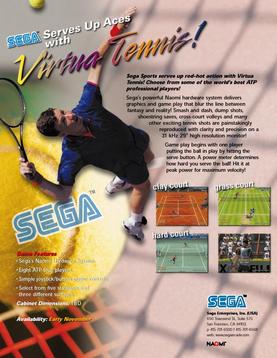
Virtua Tennis, known in Japan as Power Smash, is a 1999 tennis arcade game created by Sega. The player competes through tennis tournaments in an arcade mode. It was ported to the Dreamcast in 2000, and to Windows in 2002. A Game Boy Advance version was also released in 2002, followed by an N-Gage version in 2003. For the home console market, the game was expanded with the introduction of the campaign mode.

Millennium Soldier: Expendable, known in Japan as Seitai Heiki Expendable, and in North America as just Expendable, is a run and gun video game that was released by Rage Software for Microsoft Windows in 1999. It was later ported to the Dreamcast and PlayStation consoles. A remake of the game, entitled Expendable: Rearmed, was released for Android in 2012. It is in the format of a modern arcade game. The player starts with 7 "credits" and can continue until running out of credits. A second player can join the game at any time by pressing start.
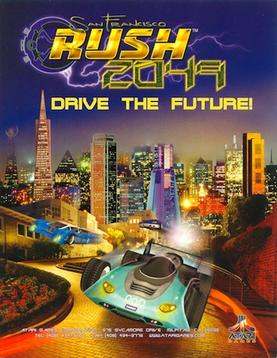
San Francisco Rush 2049 is a racing video game developed and manufactured by Atari Games for arcades. It was ported to the Nintendo 64, Game Boy Color, and Dreamcast by Midway Games West. The arcade machine was released in 1999; home versions followed in 2000 on September 7 for North America and November 17 for Europe. It is the third game in the Rush series and the sequel to San Francisco Rush: Extreme Racing and Rush 2: Extreme Racing USA. It is the last game in the Rush series to be set in the city of San Francisco and the last released on a Nintendo console. It also serves as the final game for the Atari Games label, which was retired shortly after the arcade release. The Dreamcast version was later re-released as part of Midway Arcade Treasures 3 for the PlayStation 2, Xbox, and GameCube and later for Microsoft Windows as part of Midway Arcade Treasures Deluxe Edition.

Virtua Tennis 2, known as Tennis 2K2 in North America and Power Smash 2 in Japan, is a sequel to Virtua Tennis that was released for the Sega Dreamcast, Sega NAOMI arcade unit and Sony's PlayStation 2 in 2001–2002. New features included the ability to slice and play as female players such as Monica Seles, Serena Williams, Venus Williams and Lindsay Davenport and the males such as Patrick Rafter, Magnus Norman, Thomas Enqvist and Carlos Moyá and mixed doubles matches. The game was created and produced by Hitmaker, with Acclaim Entertainment publishing it in Europe for the PS2. This was the last Virtua Tennis game to be released for the Dreamcast following its discontinuation.

Sega Rally 2 is an arcade racing game developed by Sega for the Model 3 arcade hardware. It is the sequel to 1994's Sega Rally Championship. The game was first released in arcades in February 1998, and was later ported to the Sega Dreamcast, becoming one of the console's earliest titles when it was released in Japan on January 28, 1999. The Sega Dreamcast version was released in Europe as a launch title on October 14, 1999, and then in North America on November 27. A PC version was released in Japan and Europe that same year, with the North American release following suit in September 2000, where it was published by Mattel Interactive.

NFL 2K2 is a 2001 video game for Dreamcast by Sega and developed by Visual Concepts. It is the last game for the Sega Dreamcast in the series after being discontinued before Sega shifted to a third party publisher. Because of this shift, it was released later for PlayStation 2 and Xbox. It is also the first Xbox game published by Sega, and the last game in the NFL 2K series to feature Randy Moss as a cover athlete.
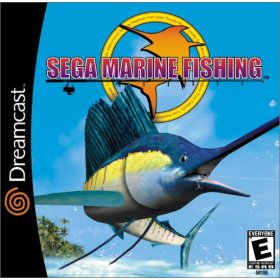
Sega Marine Fishing is a fishing video game published by Sega for arcade games, Dreamcast and Microsoft Windows in 1999-2002.

Tokyo Xtreme Racer 2, known as Shutokō Battle 2 in Japan and Tokyo Highway Challenge 2 in Europe, is the sequel to Tokyo Xtreme Racer, which is also on the Dreamcast. Tokyo Xtreme Racer 2 has been enhanced with better sound quality and graphics over its predecessor. The game managed to produce two more sequels. It is the last game in the series that was produced for Sega Dreamcast, though some of the game's mechanics were implemented into Daytona USA 2001.

WWF Attitude is a professional wrestling video game based on the World Wrestling Federation released by Acclaim Entertainment in 1999 for the PlayStation and Nintendo 64. A slightly enhanced port of the game was later released for the Dreamcast, as well as a handheld version for the Game Boy Color. The game is named after the WWF's then-current "Attitude" marketing campaign, with the tagline "Get it" also being used on company programming during that period.
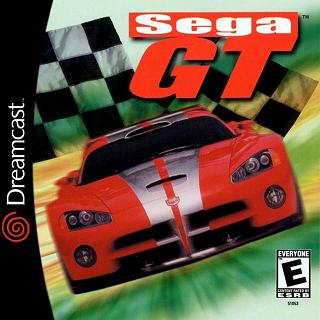
Sega GT, released in Japan as Sega GT: Homologation Special, is a sim racing video game co-developed by Wow Entertainment and TOSE, and published by Sega for their Dreamcast home console. The game was released in 2000. A Microsoft Windows version was published the following year—in Japan by Sega, in North America by Activision Value, and in Europe by Empire Interactive.
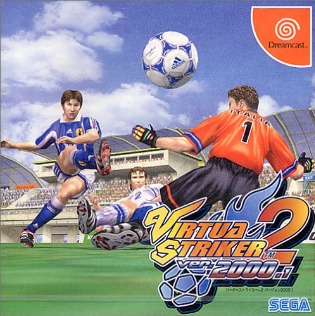
Virtua Striker 2 is a sports video game developed and published by Sega for arcades in 1997. It is the sequel to the 1994 video game Virtua Striker, and the second game in the Virtua Striker series. A series of updates was released from 1998 to 1999, starting with Virtua Striker 2 ver. 1998 and ending with Virtua Striker 2 ver. 2000.1, that latest update being released for the Dreamcast in Japan in 1999, and then internationally in 2000, with the North American version re-titled to Virtua Striker 2. A sequel, Virtua Striker 3, was released in 2001.
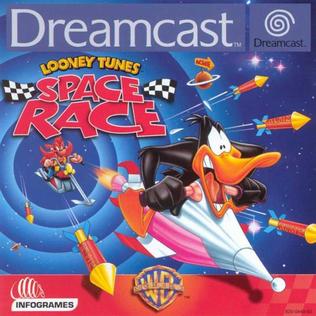
Looney Tunes: Space Race is a 2000 kart-racing video game published by Infogrames for the Dreamcast and developed through Infogrames' own Melbourne House studio. A version of Nintendo 64 was developed, but it was never released. It was ported to PlayStation 2 in 2002 with a new tournament mode and different soundtrack.

Vanishing Point is a racing video game developed by Clockwork Games and published by Acclaim Entertainment for Dreamcast and PlayStation.

Ultimate Fighting Championship is the first video game based on the Ultimate Fighting Championship mixed martial arts promotion. It was first developed by Anchor Inc. for the Sega Dreamcast on August 29, 2000, then by Fluid Studios for the Game Boy Color on November 27 the same year, and finally by Opus for the Sony PlayStation on December 1 the same year. All three versions of the game were published by Crave Entertainment in North America, while Ubi Soft published the three versions in Europe and Capcom published the Dreamcast and PlayStation versions in Japan.

International Track & Field 2000 is a track and field game for PlayStation in 1999 and Nintendo 64 in 2000. It was released in Europe under the names International Track & Field: Summer Games on the Nintendo 64 and Game Boy Color, International Track & Field 2 on the PlayStation and International Track & Field on the PlayStation 2 and in Japan as Ganbare! Nippon! Olympics 2000, where it was licensed by the Japanese Olympic Committee. Versions were also released for the Sega Dreamcast, PlayStation 2, and Game Boy Color as ESPN International Track & Field in North America. Maurice Greene, a former men's WR holder in the 100M dash, is the cover athlete.

UEFA Striker, known in North America as Striker Pro 2000, is a sports video game developed by Rage Software and published by Infogrames in 1999-2000. It is the final game in the Striker series following the cancellation of its sequel, UEFA 2001, the following year.

Championship Surfer is an extreme sports video game developed by Krome Studios, published by Mattel Interactive in North American and GAME Studios in Europe, and released for Microsoft Windows, PlayStation and Dreamcast in 2000.

Le Mans 24 Hours is a video game released for the PlayStation, Game Boy Color, Dreamcast, PlayStation 2, and Microsoft Windows. The Dreamcast version was ported and published by Sega in Japan on 15 March 2001, while the PlayStation 2 version was ported and published by the same company on 13 June. Based on the famous 24 hours of Le Mans race in France, the player is invited to race the entire 24-hour endurance course or take part in a simpler arcade mode. The game also featured tracks such as Bugatti Circuit, Brno Circuit, Road Atlanta, Suzuka Circuit, Donington Park and Circuit de Catalunya, as well as a weather and night system.
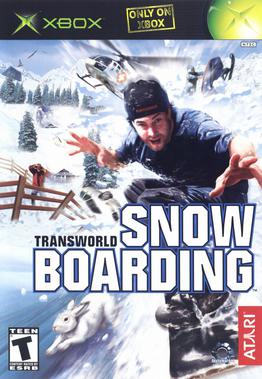
Transworld Snowboarding is a snowboarding video game developed by Housemarque and published by Infogrames, released in 2002, for the Xbox. It is a sequel to Supreme Snowboarding.

Test Drive Cycles is a racing video game developed by American studio Xantera and published by Infogrames exclusively for Game Boy Color. It is the first game in the Test Drive series to feature motorcycles.




















